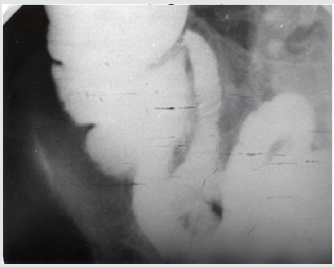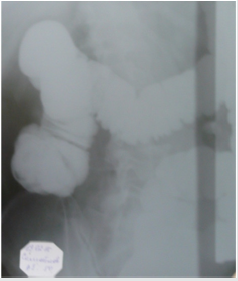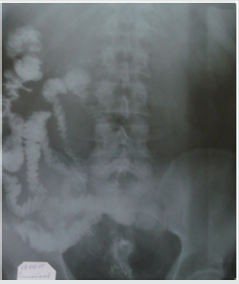Lupine Publishers| Journal of Gastroenterology and Hepatology
Abstract
The goal is to assess the impact of biogenetic on the condition of patients with psoriasis
Materials and Methods: The study group included 415 patients aged 19 to 65 years (34% of men and 66% of women), in whom irrigoscopy revealed the injection of contrast into the ileum, i.e., the insolvency of the baugine flap (NBZ) was diagnosed, 74 of them suffered from psoriasis. For the detection of chronic intoxication were evaluated the data of clinical manifestations, indican urine, level of middle molecules, blood serum, lipid metabolism, microbial resistance, the hydrogen breath test.
Results: NBZ is a chronic endointoxication, which regresses in collaboration with the clinical manifestations of psoriasis after biogenetic.
Conclusion: Hypothesized that NBZ is one of the causes of psoriasis, and biogenetica – link in etiopathogenetic method of treatment.
Keywords: Insolvency bauhinias dampers; Chronic endo intoxication; Psoriasis; surgery
Introduction
Recognizing the harmfulness of dysfunction of such barrier
structures as cardia, pylorus, sphincter of Oddi, heart valves, venous
valves of the lower extremities, etc., modern medicine ignores the
failure of the ileocecal locking system (Bauhinia valve) as a possible
cause of the pathology of the digestive system and associated
various extraintestinal diseases [1].
But it is worth paying attention to the opinion of I.I. Grekova
[2] “Despite a number of works devoted to the proximal colon,
the pathology of this department is still not sufficiently explained
because in these works the role of the bauhinia valve was completely
ignored.” Bauhinia valve (BZ) distinguishes between the functions
of the small and large intestines, isolates the small intestine from
the reflux of the colonic contents, which differs sharply in chemical
composition, physical condition and bacterial spectrum [3-5].
According to LG Peretz [6], in 1 ml of intestinal contents there
are up to 5000 microbes, and in 1 g of the contents of the large
intestine there are about 30-40 billion [6]. With the failure of the
Bauhinia Damper (NBZ), billions of colon microbes are thrown
into the small one [4,6], colonization of the small intestine with
allochthonous (alien) microorganisms occurs, excessive bacterial
growth syndrome (SIBO) or enteric dysbacteriosis develops [7,8].
Absorbing the blood products of microorganisms (indole,
phenol, cresol, skatole, pyrocatechin, carbolic acid, hydrogen
sulfide, mercaptan, ethane, methane, etc.) causes autointoxication
phenomena that cannot be sufficiently arrested, especially for liver
diseases [7,9-11].
The development of putrefactive and fermentation processes in
the small intestine - The consequence of the SIBO. The lymphoid
tissue in the course of the gastrointestinal tract suffers because
of a violation of the barrier function of the intestinal wall [4,12],
resulting in a deficiency of immunoglobulins A and M. In 70% of
patients with chronic enterocolitis there is a marked decrease in the
body’s immunological reactivity the body becomes less protected
before microbial aggression - in patients with chronic colitis [5].
Recognizing NBZ as one of the anatomical causes of SIBR,
nevertheless, the authors do not have a therapeutic effect on it [13,14], although they assign SIBOs key pathogenetic mechanisms
in many diseases of the digestive tract and associated extradigestive
conditions [7,10].
The interrelation between the pathology of the gastrointestinal
tract (GIT) and the development of dermatosis is a well-known fact.
The small intestine is the organ of the digestive canal, the most
responsible for the development of dermatosis. The relationship
between the intensity of skin manifestations and the activity of
ileocolitis Roberts et al. [15] with psoriasis was detected in 2/3 of
patients with enterocolitis [15]. Sensitization to intestinal autoflora
was revealed. So sharply positive were skin tests, primarily to
Escherichia coli-up to 97% [16]. Allergic dermatosis, rosacea,
seborrhea, food allergy, urticaria, neurodermatitis were found
in 176 (22%) of 800 patients with diseases of the alimentary
canal [17]. In the etipathogenesis of dermatosis, the following
enterocolitic links are distinguished [18].
a. The most responsible for the development of dermatosis is
the small intestine. The immune complexes formed in the intestine
penetrate the blood and settle in various tissues, including the skin
with the development of immediate and delayed hypersensitivity
types.
b. There is a shortage of many substances as a result of
malabsorption in the small intestine, in particular vitamins, whose
participation in the pathogenesis of dermatosis is large.
c. The use of sorbents, hemosorption, plasmapheresis
significantly improves the effect of therapy, which confirms the role
of endogenous intoxication in the development of dermatoses.
The goal is to assess the effect of Bauhinoplasty on the condition
of patients suffering from psoriasis.
Materials and Methods
The study group included 415 patients aged from 19 to 65 years old (34% of men and 66% of women), in whom a reflux of contrast into the ileum, i.e. diagnosed NBZ (Figure 1). In 111 patients, reflux of the radiopaque substance to the ileum was regarded by doctors as the norm. But all surveyed to the question: “Do you consider yourself ill?” answered in the affirmative. From the onset of the first signs of the disease, 15% of those examined passed from 1 year to 5 years, 32% have from 5 to 10 years, and 53% have more than 10 years. Of the 415 patients with NBZ, 74 suffered from psoriasis. Previously, they identified: chronic gastritis - in 62.5%, chronic cholecystitis - in 37%, chronic gastroduodenitis - in 12.5%, chronic colitis - in 12.5%, chronic pancreatitis - in 6%, duodenal ulcer - 6%. In 6% of patients with a history of appendectomy.
Research methods
Irrigoscopy: It is important to note that the refusal to hold a tight filling of the cecum at NBZ can lead to a false-negative conclusion. A repeated X-ray examination immediately after a bowel movement is of fundamental importance, since during a bowel movement a maximum pressure is created in the bowel, which at the NBZ will be accompanied by a pronounced reflux of the radiopaque substance into the ileum (Figures 1-3).
Figure 1: Before surgery on irrigography all patients is determined by the reflux of contrast material into the ileum.

Figure 2: Patient S, Irrigography with tight filling of the cecum was performed prior to defecation, regurgitation of contrast and the cecum into the ileum is not detected.

Figure 3: The same patient S. Irrigography performed after defecation, define a significant reflux of barium into the small intestine.

Chronic autointoxication was detected by such studies as
urine indican (Obermeyer was tested for this purpose.), The level
of the average serum molecules was measured according to N.I.
Gabrielyana, lipid metabolism.
Microbial resistance was determined by the content of
antibodies to peptidoglycan Staphylococcus aureus (method of
Professor A.N. Mayansky). Peptidoglycan is the most common
element of the cell wall of all bacteria, which makes it possible to
indirectly judge the content of anti-peptidoglycan antibodies in
general. The content of antibodies to peptidoglycan Staphylococcus
aureus (strain 885, solubilized by ultrasound) was determined.
Each sample was placed in 3 repetitions, calculating the average
result. Negative controls were the wells in which the stage of
treatment with the antigen (peptidoglycan) was omitted. Indicators
of negative control from the results of the experiments were
subtracted. A pool of 25 sera from healthy donors was used as a
positive control. The results are statistically processed on the IBM
/ AT-286 computer using the following criteria: determination of
averages, Fisher criterion, Wilcoxon-Whitney-Mann criterion.
Read More About Lupine Publishers Journal of Gastroenterology and Hepatology Please Click on Below Link: https://currenttrendsingastroenterology.blogspot.com/

No comments:
Post a Comment
Note: only a member of this blog may post a comment.